flat tire TOYOTA TACOMA 2020 Warranties & Maintenance Guides (in English)
[x] Cancel search | Manufacturer: TOYOTA, Model Year: 2020, Model line: TACOMA, Model: TOYOTA TACOMA 2020Pages: 260, PDF Size: 8.54 MB
Page 26 of 260
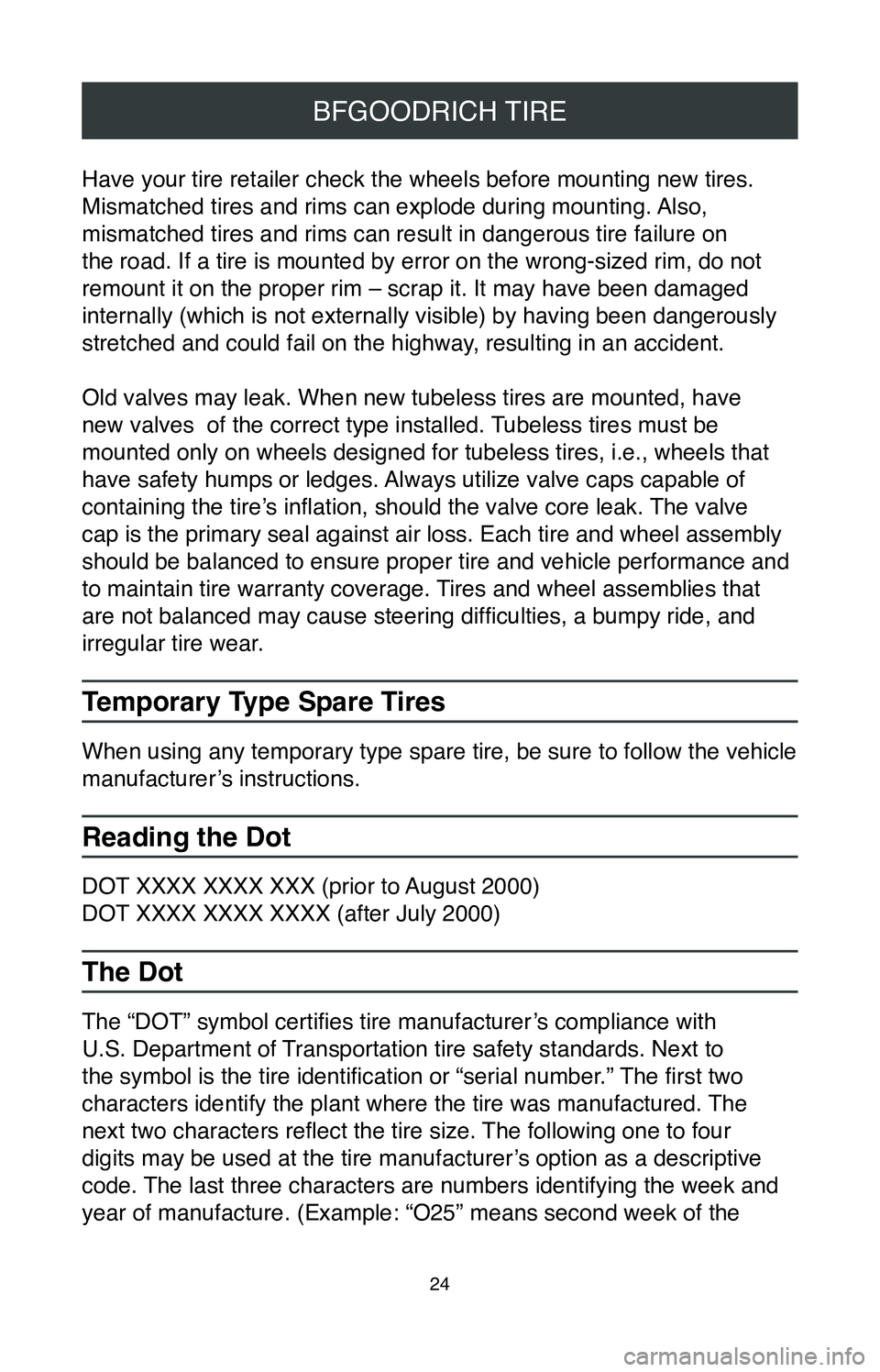
24
BFGOODRICH TIRE
Have your tire retailer check the wheels before mounting new tires.
Mismatched tires and rims can explode during mounting. Also,
mismatched tires and rims can result in dangerous tire failure on
the road. If a tire is mounted by error on the wrong-sized rim, do not
remount it on the proper rim – scrap it. It may have been damaged
internally (which is not externally visible) by having been dangerously
stretched and could fail on the highway, resulting in an accident.
Old valves may leak. When new tubeless tires are mounted, have
new valves of the correct type installed. Tubeless tires must be
mounted only on wheels designed for tubeless tires, i.e., wheels that
have safety humps or ledges. Always utilize valve caps capable of
containing the tire’s inflation, should the valve core leak. The valve
cap is the primary seal against air loss. Each tire and wheel assembly
should be balanced to ensure proper tire and vehicle performance and
to maintain tire warranty coverage. Tires and wheel assemblies that
are not balanced may cause steering difficulties, a bumpy ride, and
irregular tire wear.
Temporary Type Spare Tires
When using any temporary type spare tire, be sure to follow the vehicle \
manufacturer’s instructions.
Reading the Dot
DOT XXXX XXXX XXX (prior to August 2000)
DOT XXXX XXXX XXXX (after July 2000)
The Dot
The “DOT” symbol certifies tire manufacturer’s compliance with
U.S. Department of Transportation tire safety standards. Next to
the symbol is the tire identification or “serial number.” The first two
characters identify the plant where the tire was manufactured. The
next two characters reflect the tire size. The following one to four
digits may be used at the tire manufacturer’s option as a descriptive
code. The last three characters are numbers identifying the week and
year of manufacture. (Example: “O25” means second week of the
Page 27 of 260
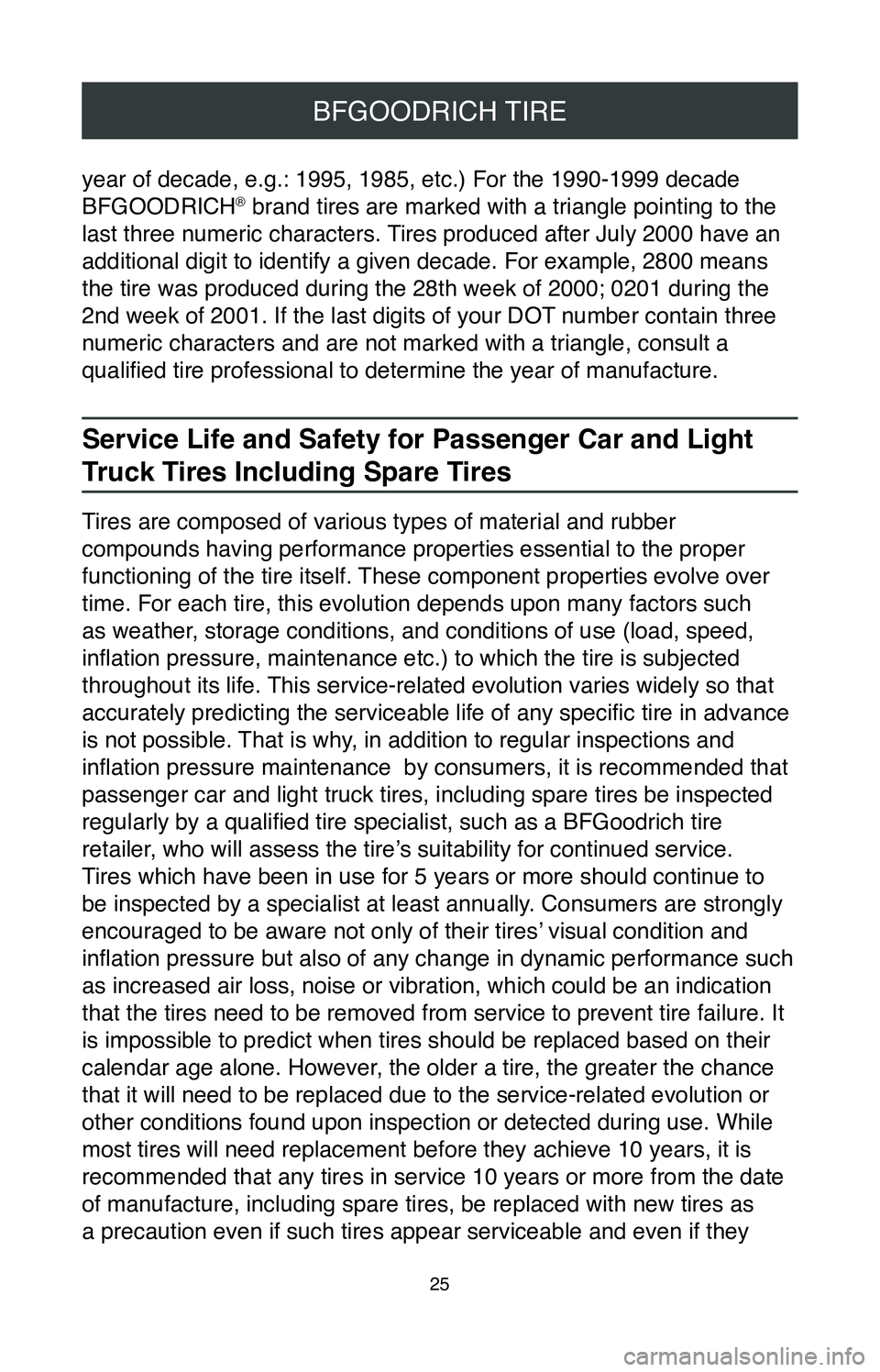
25
BFGOODRICH TIRE
year of decade, e.g.: 1995, 1985, etc.) For the 1990-1999 decade
BFGOODRICH® brand tires are marked with a triangle pointing to the
last three numeric characters. Tires produced after July 2000 have an
additional digit to identify a given decade. For example, 2800 means
the tire was produced during the 28th week of 2000; 0201 during the
2nd week of 2001. If the last digits of your DOT number contain three
numeric characters and are not marked with a triangle, consult a
qualified tire professional to determine the year of manufacture.
Service Life and Safety for Passenger Car and Light
Truck Tires Including Spare Tires
Tires are composed of various types of material and rubber
compounds having performance properties essential to the proper
functioning of the tire itself. These component properties evolve over
time. For each tire, this evolution depends upon many factors such
as weather, storage conditions, and conditions of use (load, speed,
inflation pressure, maintenance etc.) to which the tire is subjected
throughout its life. This service-related evolution varies widely so that
accurately predicting the serviceable life of any specific tire in advance
is not possible. That is why, in addition to regular inspections and
inflation pressure maintenance by consumers, it is recommended that
passenger car and light truck tires, including spare tires be inspected \
regularly by a qualified tire specialist, such as a BFGoodrich tire
retailer, who will assess the tire’s suitability for continued service.
Tires which have been in use for 5 years or more should continue to
be inspected by a specialist at least annually. Consumers are strongly
encouraged to be aware not only of their tires’ visual condition and
inflation pressure but also of any change in dynamic performance such
as increased air loss, noise or vibration, which could be an indication \
that the tires need to be removed from service to prevent tire failure. \
It
is impossible to predict when tires should be replaced based on their
calendar age alone. However, the older a tire, the greater the chance
that it will need to be replaced due to the service-related evolution or
other conditions found upon inspection or detected during use. While
most tires will need replacement before they achieve 10 years, it is
recommended that any tires in service 10 years or more from the date
of manufacture, including spare tires, be replaced with new tires as
a precaution even if such tires appear serviceable and even if they
Page 28 of 260
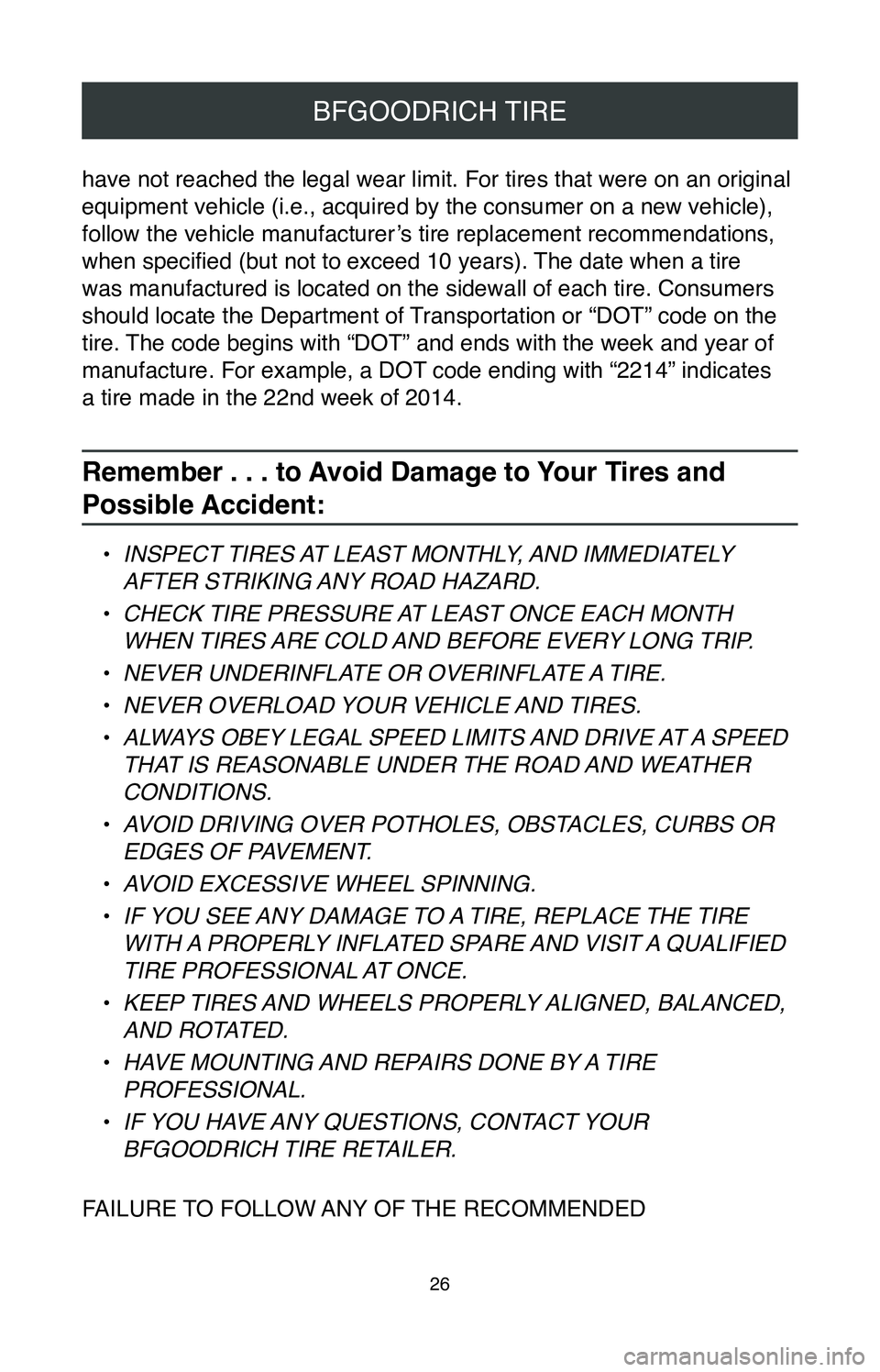
26
BFGOODRICH TIRE
have not reached the legal wear limit. For tires that were on an origina\
l
equipment vehicle (i.e., acquired by the consumer on a new vehicle),
follow the vehicle manufacturer’s tire replacement recommendations,
when specified (but not to exceed 10 years). The date when a tire
was manufactured is located on the sidewall of each tire. Consumers
should locate the Department of Transportation or “DOT” code on the
tire. The code begins with “DOT” and ends with the week and year of
manufacture. For example, a DOT code ending with “2214” indicates
a tire made in the 22nd week of 2014.
Remember . . . to Avoid Damage to Your Tires and
Possible Accident:
• INSPECT TIRES AT LEAST MONTHLY, AND IMMEDIATELY
AFTER STRIKING ANY ROAD HAZARD.
•
CHECK TIRE PRESSURE AT LEAST ONCE EACH MONTH
WHEN TIRES ARE COLD AND BEFORE EVERY LONG TRIP.
•
NEVER UNDERINFLATE OR OVERINFLATE A TIRE.
•
NEVER OVERLOAD YOUR VEHICLE AND TIRES.
•
ALWAYS OBEY LEGAL SPEED LIMITS AND DRIVE AT A SPEED
THAT IS REASONABLE UNDER THE ROAD AND WEATHER
CONDITIONS.
•
AVOID DRIVING OVER POTHOLES, OBSTACLES, CURBS OR
EDGES OF PAVEMENT.
•
AVOID EXCESSIVE WHEEL SPINNING.
•
IF YOU SEE ANY DAMAGE TO A TIRE, REPLACE THE TIRE
WITH A PROPERLY INFLATED SPARE AND VISIT A QUALIFIED
TIRE PROFESSIONAL AT ONCE.
•
KEEP TIRES AND WHEELS PROPERLY ALIGNED, BALANCED,
AND ROTATED.
•
HAVE MOUNTING AND REPAIRS DONE BY A TIRE
PROFESSIONAL.
•
IF YOU HAVE ANY QUESTIONS, CONTACT YOUR
BFGOODRICH TIRE RETAILER.
FAILURE TO FOLLOW ANY OF THE RECOMMENDED
Page 30 of 260
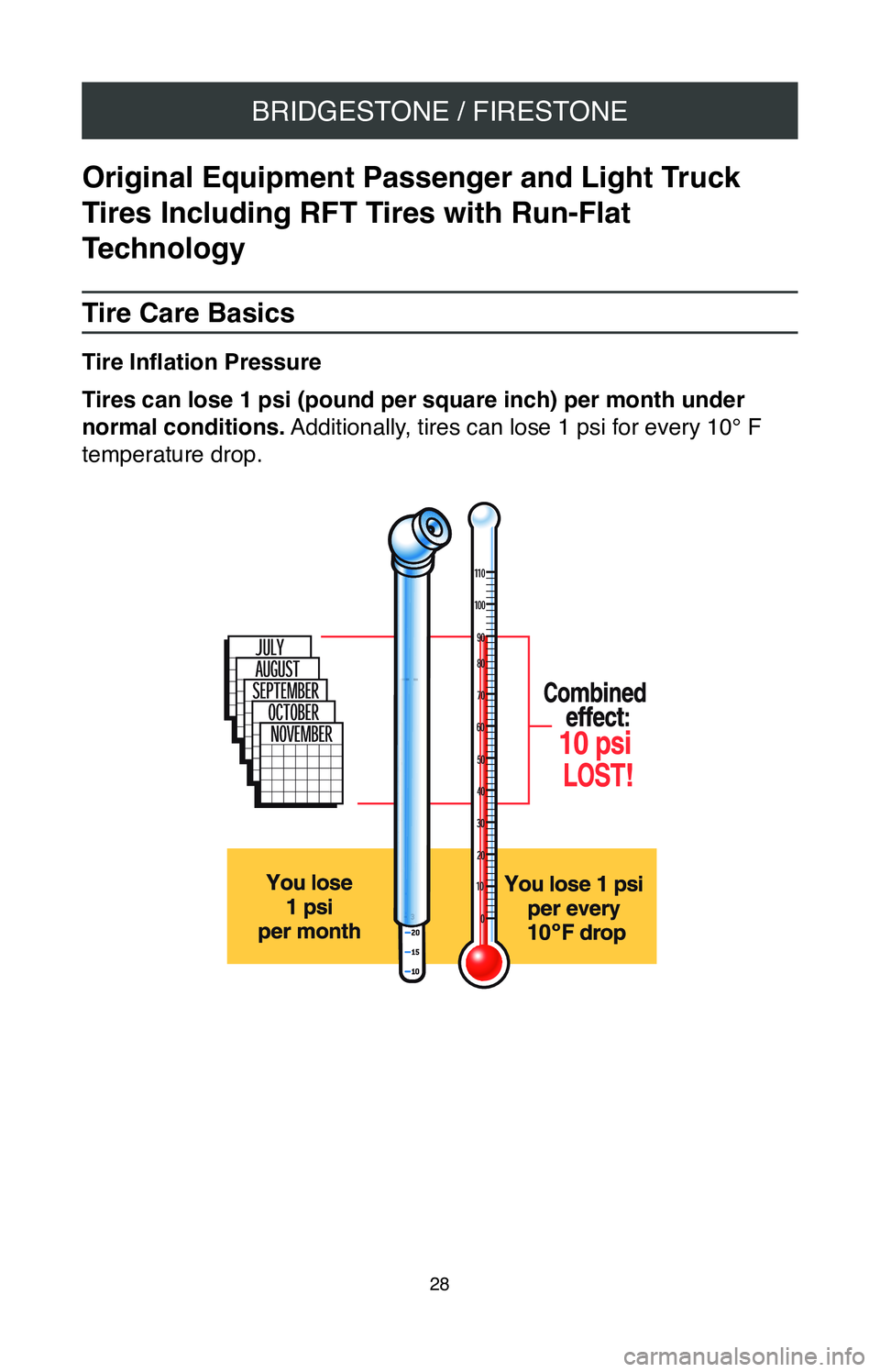
BRIDGESTONE / FIRESTONE
28
Original Equipment Passenger and Light Truck
Tires Including RFT Tires with Run-Flat
Technology
Tire Care Basics
Tire Inflation Pressure
Tires can lose 1 psi (pound per square inch) per month under
normal conditions. Additionally, tires can lose 1 psi for every 10° F
temperature drop.
Page 31 of 260
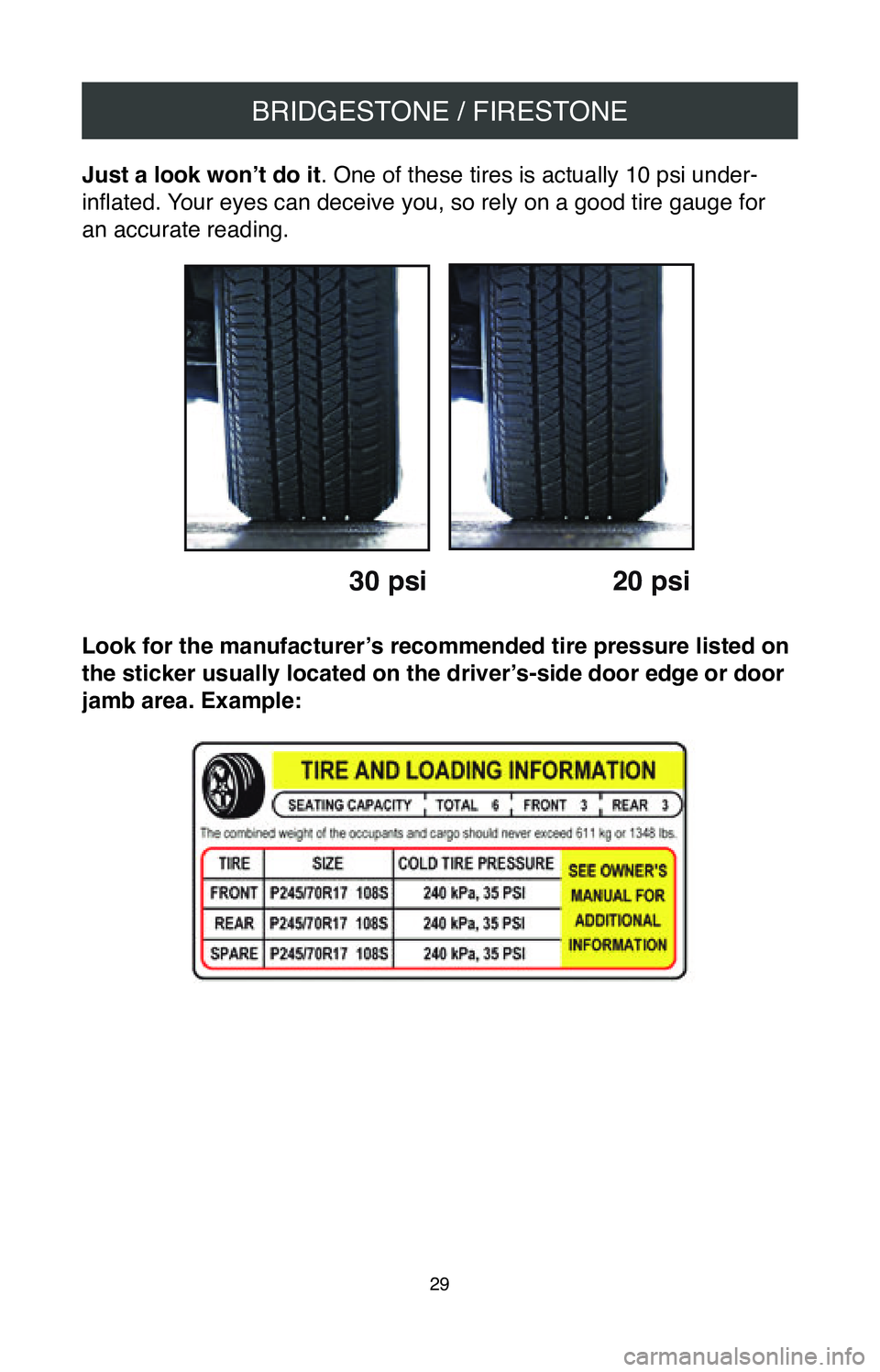
BRIDGESTONE / FIRESTONE
29
Just a look won’t do it. One of these tires is actually 10 psi under-
inflated. Your eyes can deceive you, so rely on a good tire gauge for
an accurate reading.
30 psi 20 psi
Look for the manufacturer’s recommended tire pressure listed on
the sticker usually located on the driver’s-side door edge or door
jamb area. Example:
Page 32 of 260
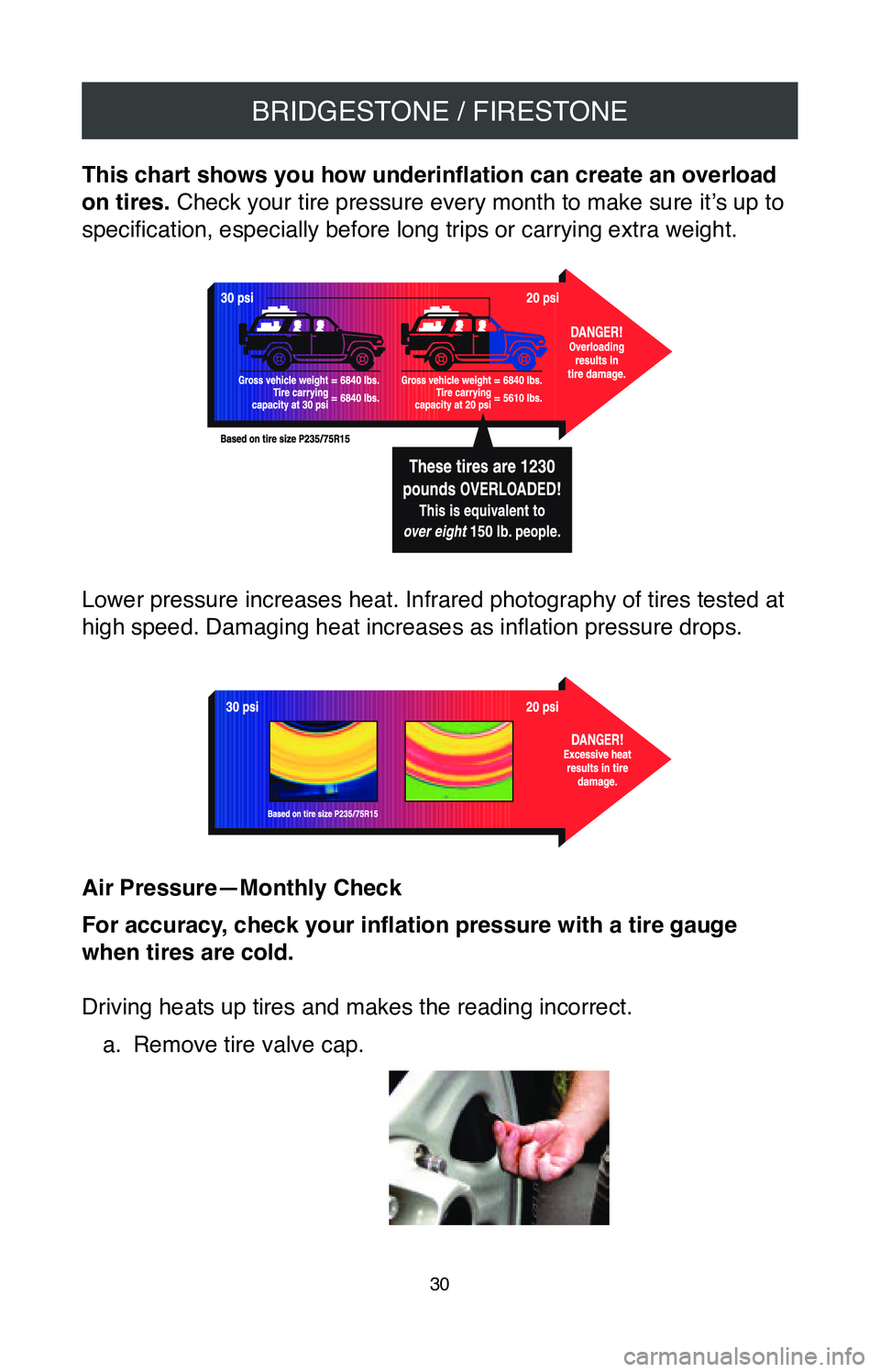
BRIDGESTONE / FIRESTONE
30
This chart shows you how underinflation can create an overload
on tires. Check your tire pressure every month to make sure it’s up to
specification, especially before long trips or carrying extra weight.
Lower pressure increases heat. Infrared photography of tires tested at
high speed. Damaging heat increases as inflation pressure drops.
Air Pressure—Monthly Check
For accuracy, check your inflation pressure with a tire gauge
when tires are cold.
Driving heats up tires and makes the reading incorrect.a.
Remove tire valve cap.
Page 35 of 260
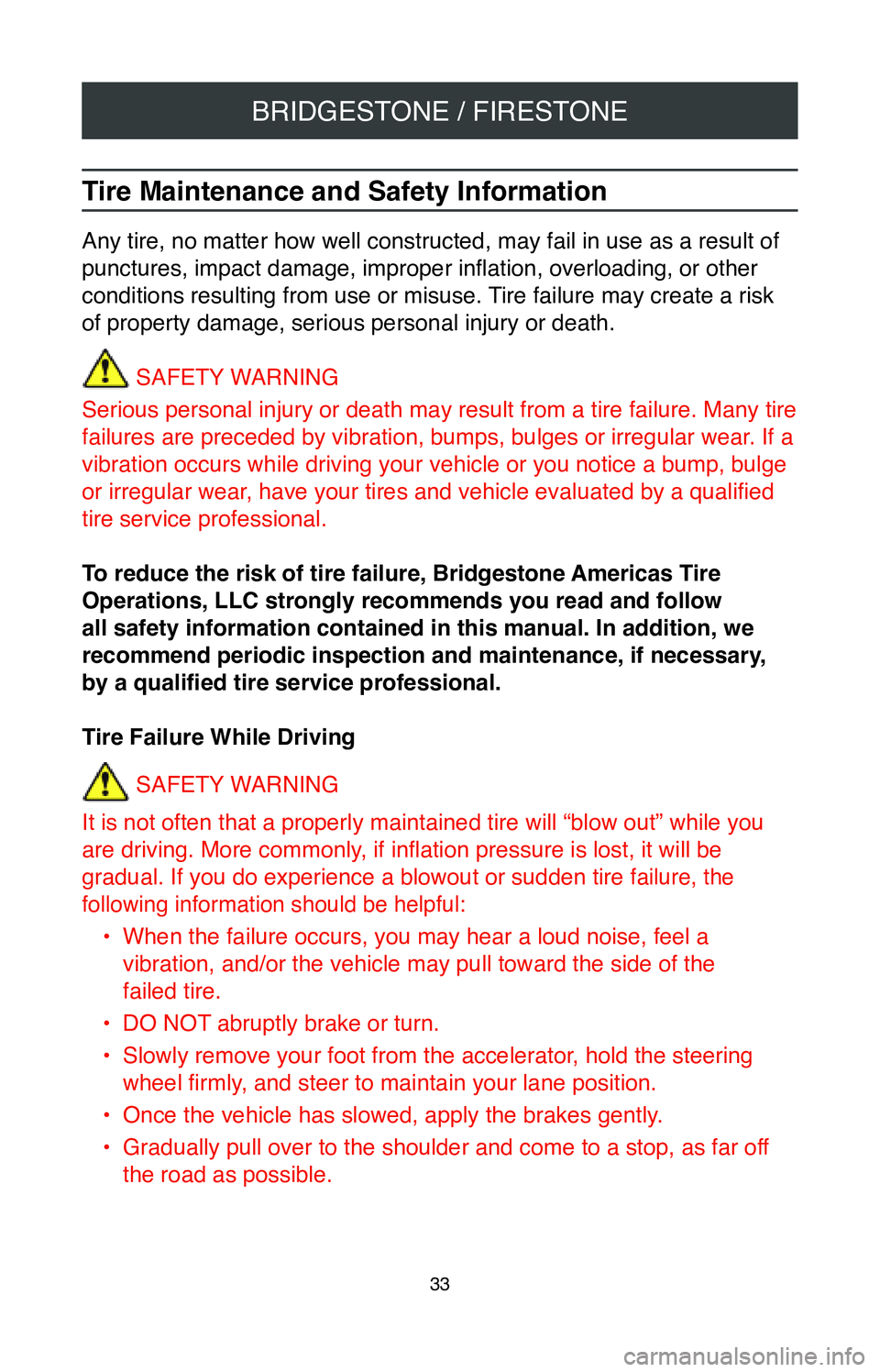
BRIDGESTONE / FIRESTONE
33
Tire Maintenance and Safety Information
Any tire, no matter how well constructed, may fail in use as a result of\
punctures, impact damage, improper inflation, overloading, or other
conditions resulting from use or misuse. Tire failure may create a risk
of property damage, serious personal injury or death.SAFETY WARNING
Serious personal injury or death may result from a tire failure. Many tire
failures are preceded by vibration, bumps, bulges or irregular wear. If a
vibration occurs while driving your vehicle or you notice a bump, bulge \
or irregular wear, have your tires and vehicle evaluated by a qualified
tire service professional.
To reduce the risk of tire failure, Bridgestone Americas Tire
Operations, LLC strongly recommends you read and follow
all safety information contained in this manual. In addition, we
recommend periodic inspection and maintenance, if necessary,
by a qualified tire service professional.
Tire Failure While Driving
SAFETY WARNING
It is not often that a properly maintained tire will “blow out” wh\
ile you
are driving. More commonly, if inflation pressure is lost, it will be
gradual. If you do experience a blowout or sudden tire
failure, the
following information should be helpful:
• When the failure occurs, you may hear a loud noise, feel a
vibration, and/or the vehicle may pull toward the side of the
failed tire.
•
DO NOT abruptly brake or turn.
•
Slowly remove your foot from the accelerator, hold the steering
wheel firmly, and steer to maintain your lane position.
•
Once the vehicle has slowed, apply the brakes gently.
•
Gradually pull over to the shoulder and come to a stop, as far off
the road as possible.
Page 36 of 260
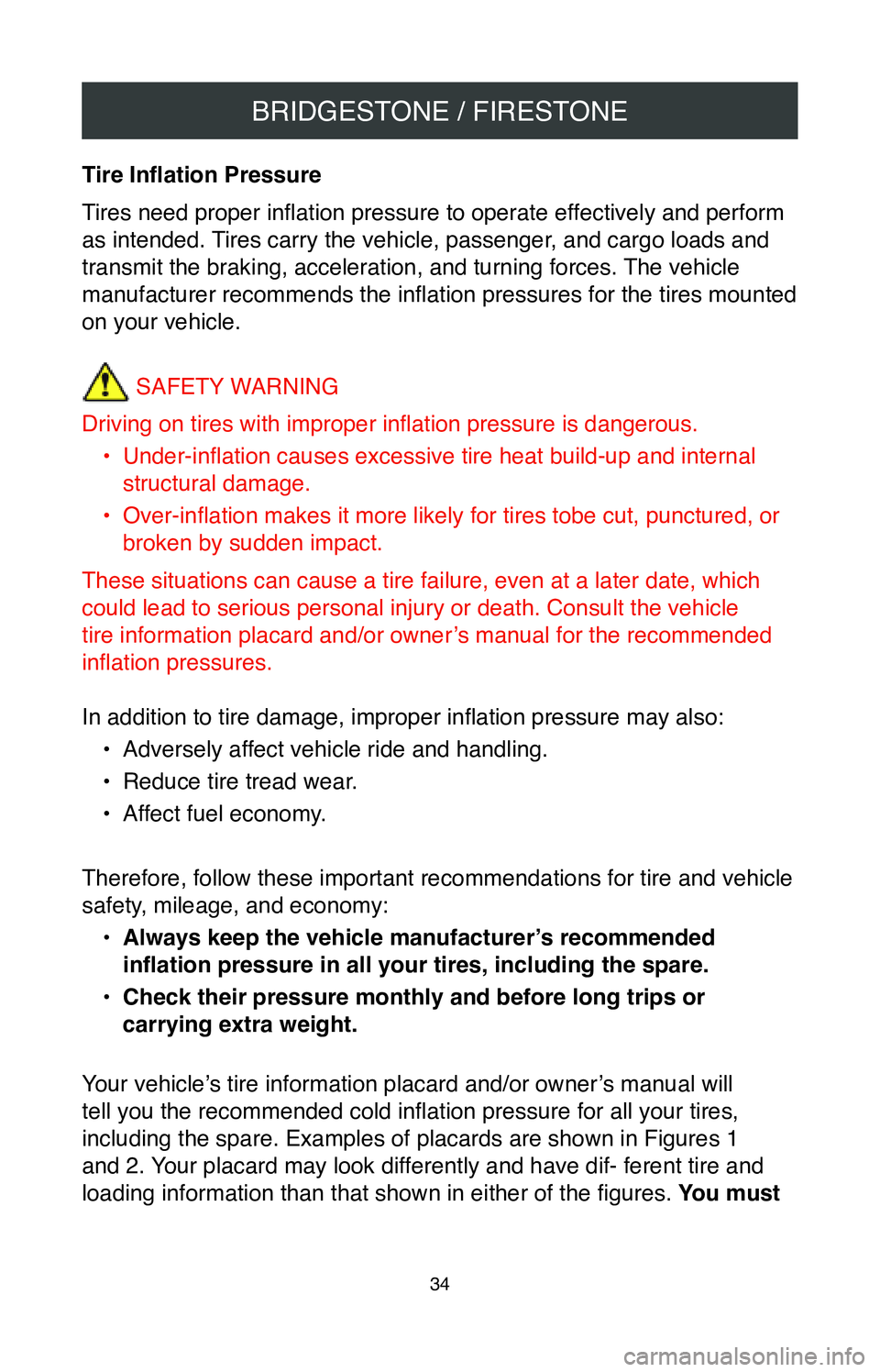
BRIDGESTONE / FIRESTONE
34
Tire Inflation Pressure
Tires need proper inflation pressure to operate effectively and perform
as intended. Tires carry the vehicle, passenger, and cargo loads and
transmit the braking, acceleration, and turning forces. The vehicle
manufacturer recommends the inflation pressures for the tires mounted
on your vehicle.SAFETY WARNING
Driving on tires with improper inflation pressure is dangerous. •
Under-inflation causes excessive tire heat build-up and internal
structural damage.
•
Over-inflation makes it more likely for tires tobe cut, punctured, or
broken by sudden impact.
These situations can cause a tire failure, even at a later date, which
could lead to serious personal injury or death. Consult the vehicle
tire information placard and/or owner’s manual for the recommended
inflation pressures.
In addition to tire damage, improper inflation pressure may also: •
Adversely affect vehicle ride and handling.
•
Reduce tire tread wear.
•
Affect fuel economy.
Therefore, follow these important recommendations for tire and vehicle
safety, mileage, and economy: •
Always keep the vehicle manufacturer’s recommended
inflation pressure in all your tires, including the spare.
•
Check their pressure monthly and before long trips or
carrying extra weight.
Your vehicle’s tire information placard and/or owner’s manual will
tell you the recommended cold inflation pressure for all your tires,
including the spare. Examples of placards are shown in Figures 1
and 2. Your placard may look differently and have dif- ferent tire and
loading information than that shown in either of the figures. You must
Page 37 of 260
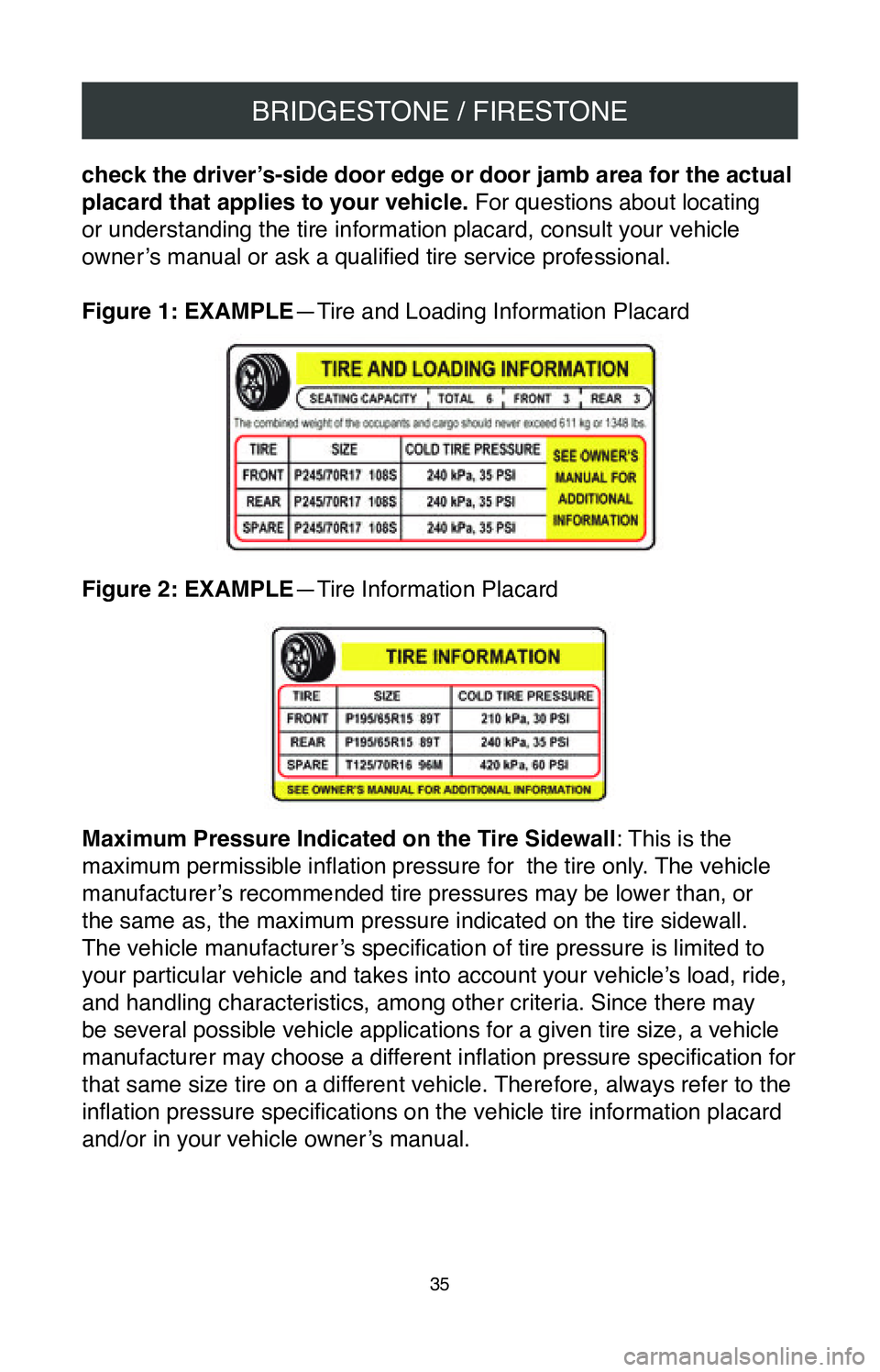
BRIDGESTONE / FIRESTONE
35
check the driver’s-side door edge or door jamb area for the actual
placard that applies to your vehicle. For questions about locating
or understanding the tire information placard, consult your vehicle
owner’s manual or ask a qualified tire service professional.
Figure 1: EXAMPLE —Tire and Loading Information Placard
Figure 2: EXAMPLE—Tire Information Placard
Maximum Pressure Indicated on the Tire Sidewall : This is the
maximum permissible inflation pressure for the tire only. The vehicle
manufacturer’s recommended tire pressures may be lower than, or
the same as, the maximum pressure indicated on the tire sidewall.
The vehicle manufacturer’s specification of tire pressure is limited to
your particular vehicle and takes into account your vehicle’s load, ride,
and handling characteristics, among other criteria. Since there may
be several possible vehicle applications for a given tire size, a vehicl\
e
manufacturer may choose a different inflation pressure specification for
that same size tire on a different vehicle. Therefore, always refer to the
inflation pressure specifications on the vehicle tire information placard
and/or in your vehicle owner’s manual.
Page 38 of 260
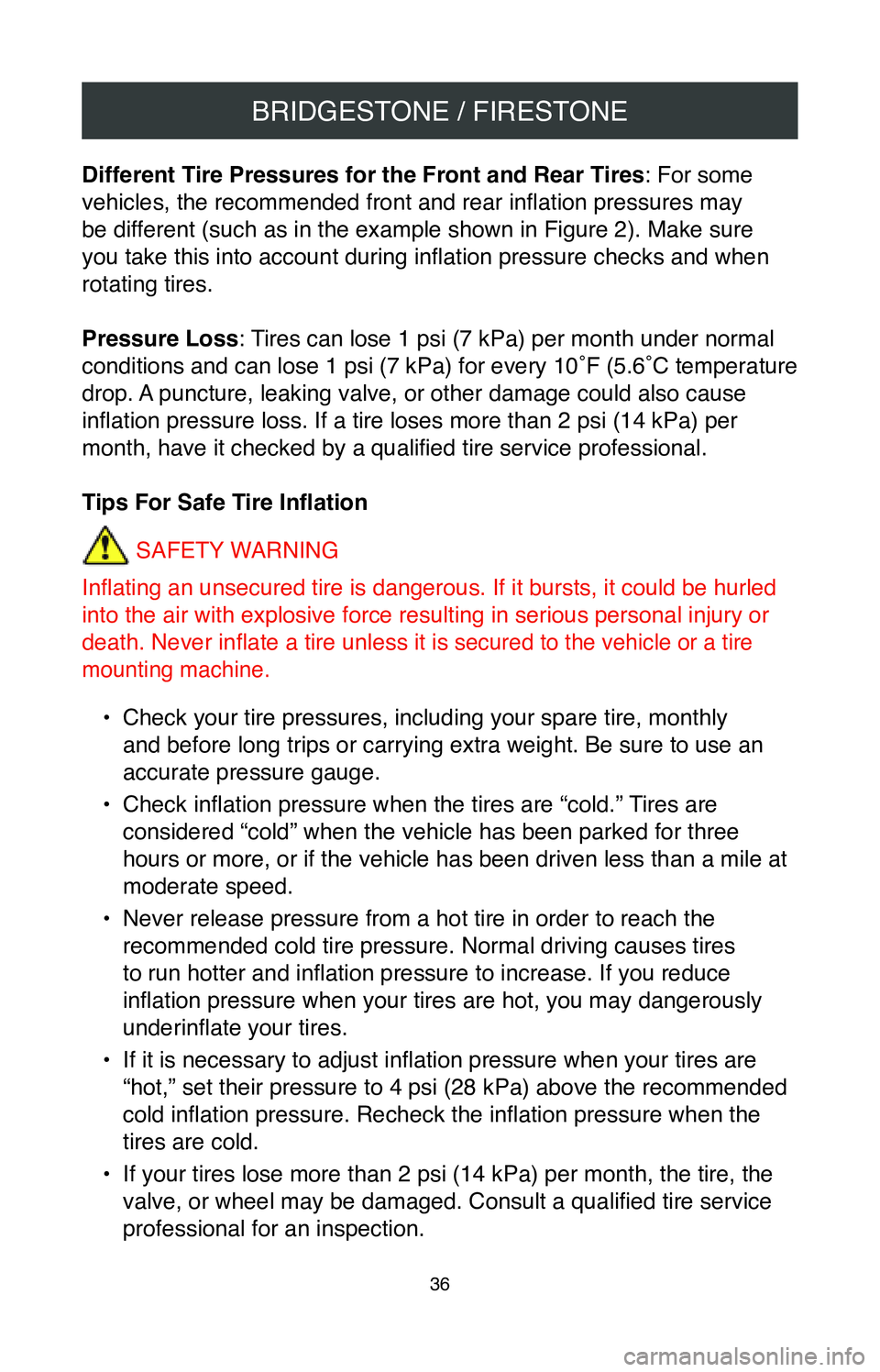
BRIDGESTONE / FIRESTONE
36
Different Tire Pressures for the Front and Rear Tires: For some
vehicles, the recommended front and rear inflation pressures may
be different (such as in the example shown in Figure 2). Make sure
you take this into account during inflation pressure checks and when
rotating tires.
Pressure Loss: Tires can lose 1 psi (7 kPa) per month under normal
conditions and can lose 1 psi (7 kPa) for every 10˚F (5.6˚C temperature
drop. A puncture, leaking valve, or other damage could also cause
inflation pressure loss. If a tire loses more than 2 psi (14 kPa) per
month, have it checked by a qualified tire service professional.
Tips For Safe Tire Inflation
SAFETY WARNING
Inflating an unsecured tire is dangerous. If it bursts, it could be hurled
into the air with explosive force resulting in serious personal injury or
death. Never inflate a tire unless it is
secured to the vehicle or a tire
mounting machine.
• Check your tire pressures, including your spare tire, monthly
and before long trips or carrying extra weight. Be sure to use an
accurate pressure gauge.
•
Check inflation pressure when the tires are “cold.” Tires are
considered “cold” when the vehicle has been parked for three
hours or more, or if the vehicle has been driven less than a mile at
moderate speed.
•
Never release pressure from a hot tire in order to reach the
recommended cold tire pressure. Normal driving causes tires
to run hotter and inflation pressure to increase. If you reduce
inflation pressure when your tires are hot, you may dangerously
underinflate your tires.
•
If it is necessary to adjust inflation pressure when your tires are
“hot,” set their pressure to 4 psi (28 kPa) above the recommended
cold inflation pressure. Recheck the inflation pressure when the
tires are cold.
•
If your tires lose more than 2 psi (14 kPa) per month, the tire, the
valve, or wheel may be damaged. Consult a qualified tire service
professional for an inspection.